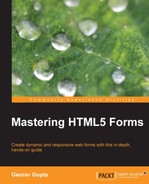In this book, you will find a number of styles of text that distinguish between different kinds of information. Here are some examples of these styles, and an explanation of their meaning.
Code words in text, database table names, folder names, filenames, file extensions, pathnames, dummy URLs, user input, and Twitter handles are shown as follows: "We can include other contexts through the use of the include directive."
A block of code is set as follows:
<div class="gender"> <label for="gender">Gender</label><br> <input type="radio" name="gender"><label>Male</label> <input type="radio" name="gender"><label>Female</label> </div><br>
When we wish to draw your attention to a particular part of a code block, the relevant lines or items are set in bold:
font-family: Helvetica, Arial, sans-serif; color: #000000; background: rgba(212,228,239,1); background: -moz-linear-gradient(top, rgba(212,228,239,1) 0%, rgba(134,174,204,1) 100%); background: -webkit-gradient(left top, left bottom, color-stop(0%, rgba(212,228,239,1)), color-stop(100%, rgba(134,174,204,1)));
New terms and important words are shown in bold. Words that you see on the screen, in menus or dialog boxes for example, appear in the text like this: " For submitting the form to the server, we have created a Submit button".
In this book, we have used ![]() for Mozilla Firefox, Google Chrome, Safari, Internet Explorer, and Opera.
for Mozilla Firefox, Google Chrome, Safari, Internet Explorer, and Opera.
